Contract Procurement for Public-Private Partnership Projects: A Case Study of New Royal Adelaide Hospital
VerifiedAdded on 2023/06/03
|16
|4229
|316
AI Summary
This document discusses the project of the new Royal Adelaide Hospital which is built using the model of public-private partnership project. It describes the life cycle of the project, key risks, dependencies, and best practices for contract and procurement management.
Contribute Materials
Your contribution can guide someone’s learning journey. Share your
documents today.

Running head: CONTRACT PROCUREMENT
Contact Procurement
Name of the Student
Name of the University
Author Note
Contact Procurement
Name of the Student
Name of the University
Author Note
Secure Best Marks with AI Grader
Need help grading? Try our AI Grader for instant feedback on your assignments.
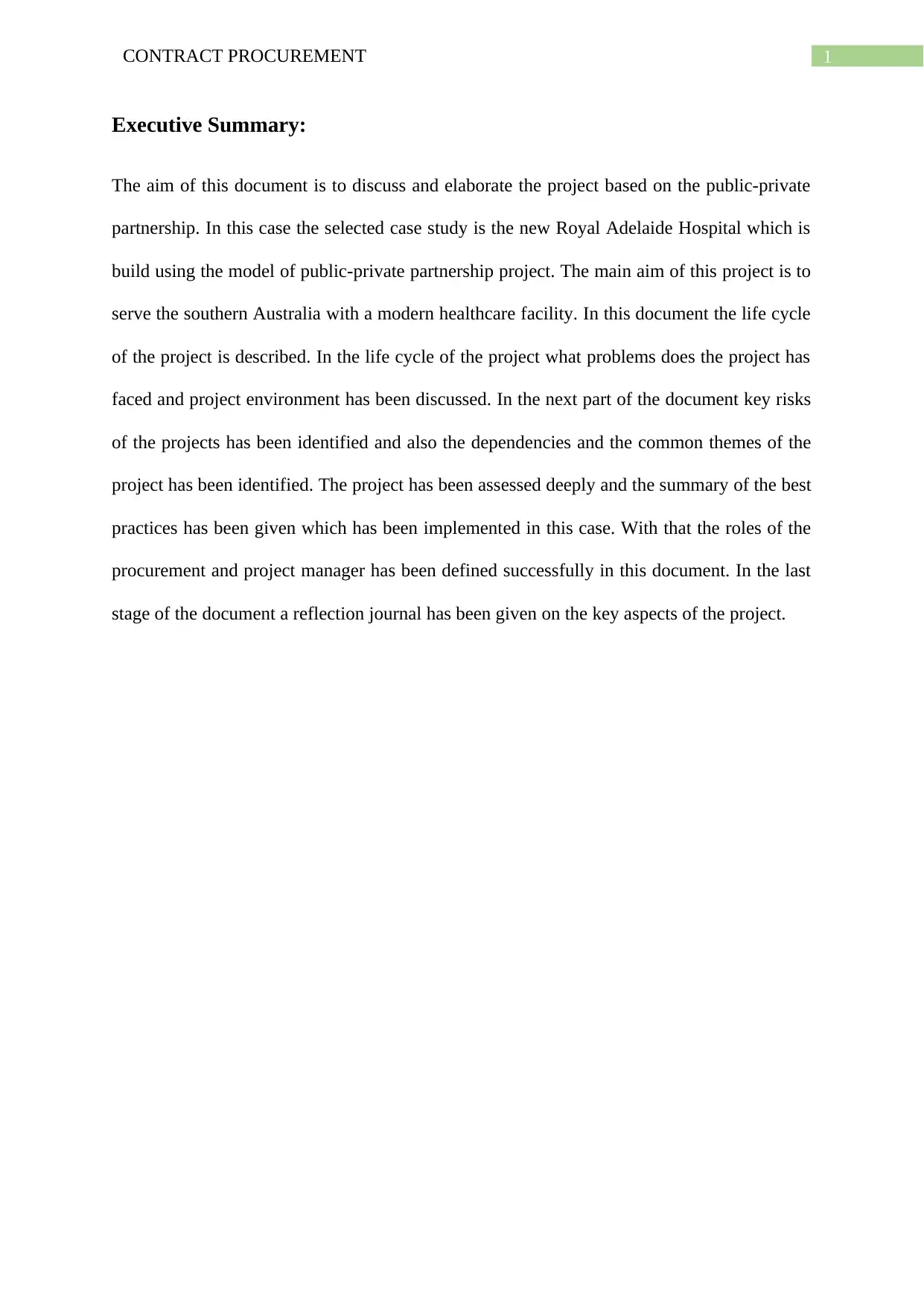
1CONTRACT PROCUREMENT
Executive Summary:
The aim of this document is to discuss and elaborate the project based on the public-private
partnership. In this case the selected case study is the new Royal Adelaide Hospital which is
build using the model of public-private partnership project. The main aim of this project is to
serve the southern Australia with a modern healthcare facility. In this document the life cycle
of the project is described. In the life cycle of the project what problems does the project has
faced and project environment has been discussed. In the next part of the document key risks
of the projects has been identified and also the dependencies and the common themes of the
project has been identified. The project has been assessed deeply and the summary of the best
practices has been given which has been implemented in this case. With that the roles of the
procurement and project manager has been defined successfully in this document. In the last
stage of the document a reflection journal has been given on the key aspects of the project.
Executive Summary:
The aim of this document is to discuss and elaborate the project based on the public-private
partnership. In this case the selected case study is the new Royal Adelaide Hospital which is
build using the model of public-private partnership project. The main aim of this project is to
serve the southern Australia with a modern healthcare facility. In this document the life cycle
of the project is described. In the life cycle of the project what problems does the project has
faced and project environment has been discussed. In the next part of the document key risks
of the projects has been identified and also the dependencies and the common themes of the
project has been identified. The project has been assessed deeply and the summary of the best
practices has been given which has been implemented in this case. With that the roles of the
procurement and project manager has been defined successfully in this document. In the last
stage of the document a reflection journal has been given on the key aspects of the project.
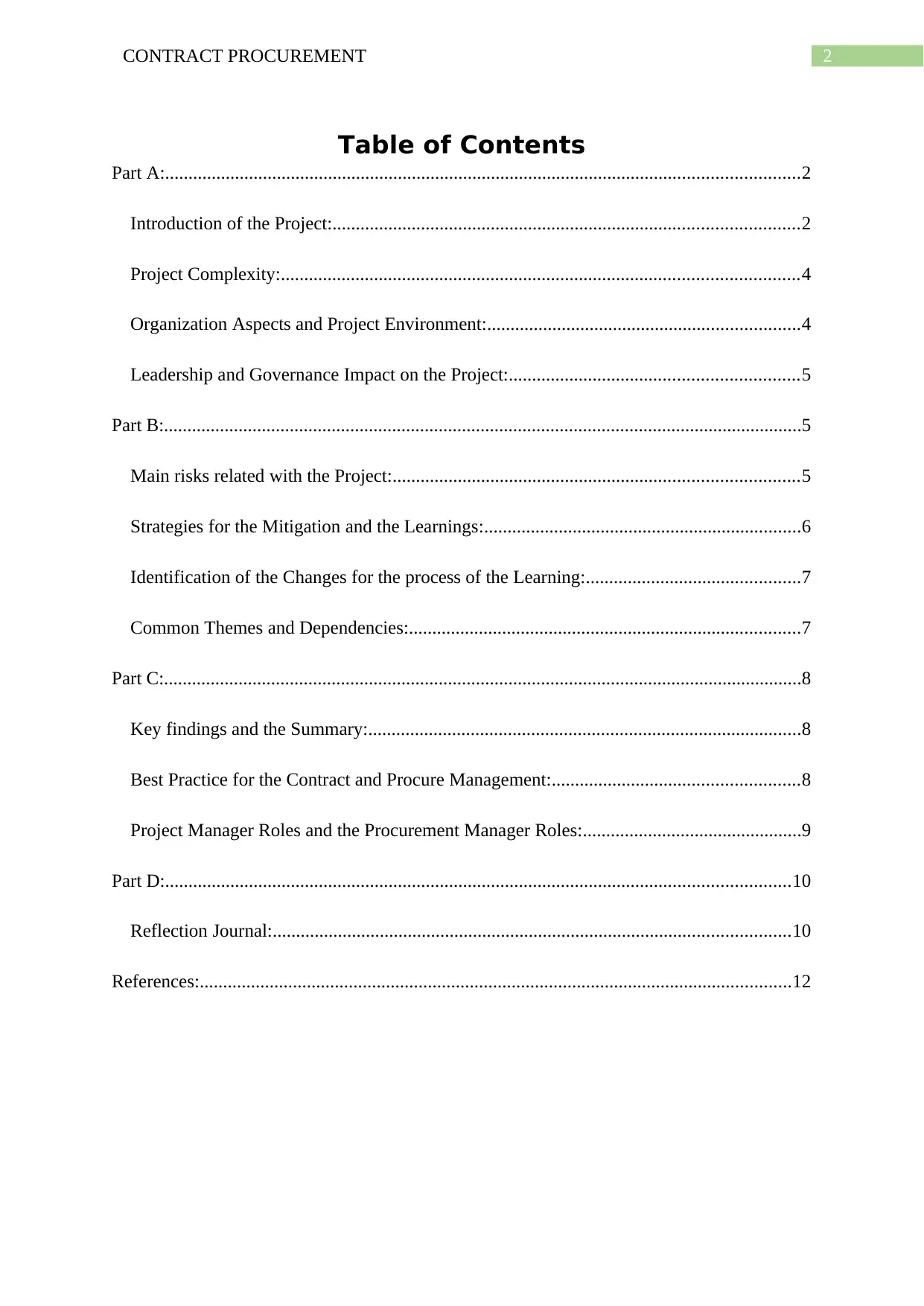
2CONTRACT PROCUREMENT
Table of Contents
Part A:........................................................................................................................................2
Introduction of the Project:....................................................................................................2
Project Complexity:...............................................................................................................4
Organization Aspects and Project Environment:...................................................................4
Leadership and Governance Impact on the Project:..............................................................5
Part B:.........................................................................................................................................5
Main risks related with the Project:.......................................................................................5
Strategies for the Mitigation and the Learnings:....................................................................6
Identification of the Changes for the process of the Learning:..............................................7
Common Themes and Dependencies:....................................................................................7
Part C:.........................................................................................................................................8
Key findings and the Summary:.............................................................................................8
Best Practice for the Contract and Procure Management:.....................................................8
Project Manager Roles and the Procurement Manager Roles:...............................................9
Part D:......................................................................................................................................10
Reflection Journal:...............................................................................................................10
References:...............................................................................................................................12
Table of Contents
Part A:........................................................................................................................................2
Introduction of the Project:....................................................................................................2
Project Complexity:...............................................................................................................4
Organization Aspects and Project Environment:...................................................................4
Leadership and Governance Impact on the Project:..............................................................5
Part B:.........................................................................................................................................5
Main risks related with the Project:.......................................................................................5
Strategies for the Mitigation and the Learnings:....................................................................6
Identification of the Changes for the process of the Learning:..............................................7
Common Themes and Dependencies:....................................................................................7
Part C:.........................................................................................................................................8
Key findings and the Summary:.............................................................................................8
Best Practice for the Contract and Procure Management:.....................................................8
Project Manager Roles and the Procurement Manager Roles:...............................................9
Part D:......................................................................................................................................10
Reflection Journal:...............................................................................................................10
References:...............................................................................................................................12
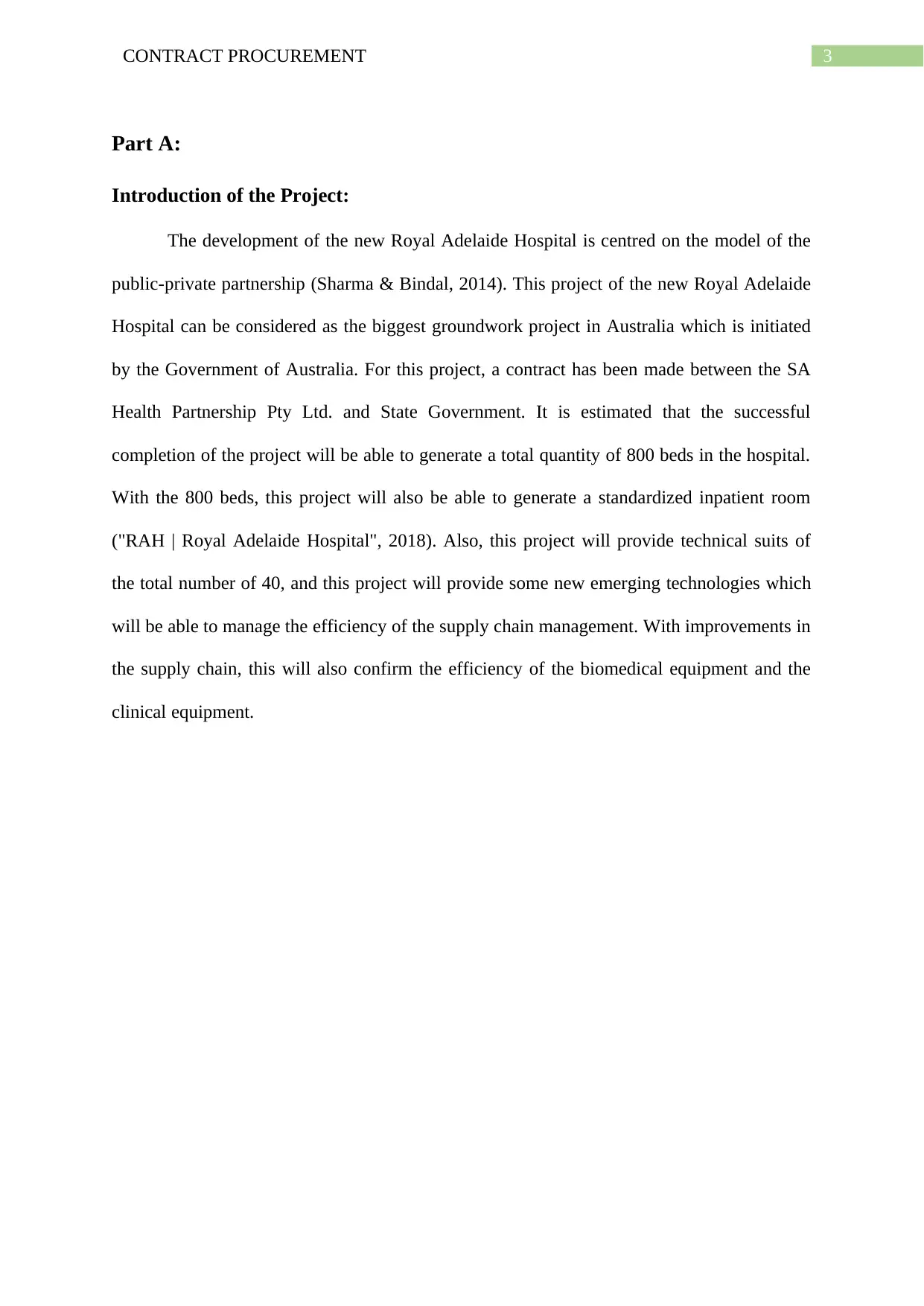
3CONTRACT PROCUREMENT
Part A:
Introduction of the Project:
The development of the new Royal Adelaide Hospital is centred on the model of the
public-private partnership (Sharma & Bindal, 2014). This project of the new Royal Adelaide
Hospital can be considered as the biggest groundwork project in Australia which is initiated
by the Government of Australia. For this project, a contract has been made between the SA
Health Partnership Pty Ltd. and State Government. It is estimated that the successful
completion of the project will be able to generate a total quantity of 800 beds in the hospital.
With the 800 beds, this project will also be able to generate a standardized inpatient room
("RAH | Royal Adelaide Hospital", 2018). Also, this project will provide technical suits of
the total number of 40, and this project will provide some new emerging technologies which
will be able to manage the efficiency of the supply chain management. With improvements in
the supply chain, this will also confirm the efficiency of the biomedical equipment and the
clinical equipment.
Part A:
Introduction of the Project:
The development of the new Royal Adelaide Hospital is centred on the model of the
public-private partnership (Sharma & Bindal, 2014). This project of the new Royal Adelaide
Hospital can be considered as the biggest groundwork project in Australia which is initiated
by the Government of Australia. For this project, a contract has been made between the SA
Health Partnership Pty Ltd. and State Government. It is estimated that the successful
completion of the project will be able to generate a total quantity of 800 beds in the hospital.
With the 800 beds, this project will also be able to generate a standardized inpatient room
("RAH | Royal Adelaide Hospital", 2018). Also, this project will provide technical suits of
the total number of 40, and this project will provide some new emerging technologies which
will be able to manage the efficiency of the supply chain management. With improvements in
the supply chain, this will also confirm the efficiency of the biomedical equipment and the
clinical equipment.
Secure Best Marks with AI Grader
Need help grading? Try our AI Grader for instant feedback on your assignments.
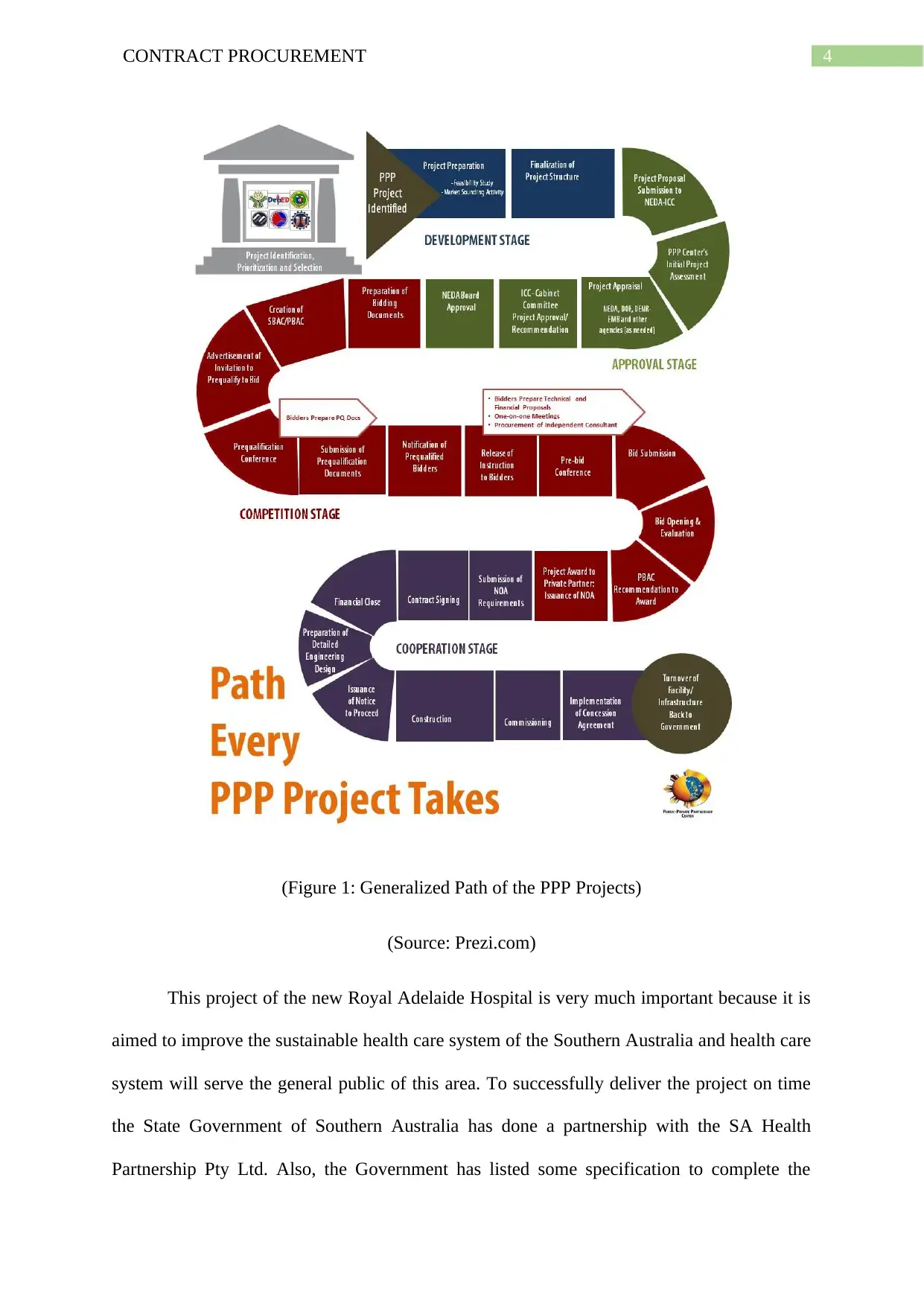
4CONTRACT PROCUREMENT
(Figure 1: Generalized Path of the PPP Projects)
(Source: Prezi.com)
This project of the new Royal Adelaide Hospital is very much important because it is
aimed to improve the sustainable health care system of the Southern Australia and health care
system will serve the general public of this area. To successfully deliver the project on time
the State Government of Southern Australia has done a partnership with the SA Health
Partnership Pty Ltd. Also, the Government has listed some specification to complete the
(Figure 1: Generalized Path of the PPP Projects)
(Source: Prezi.com)
This project of the new Royal Adelaide Hospital is very much important because it is
aimed to improve the sustainable health care system of the Southern Australia and health care
system will serve the general public of this area. To successfully deliver the project on time
the State Government of Southern Australia has done a partnership with the SA Health
Partnership Pty Ltd. Also, the Government has listed some specification to complete the
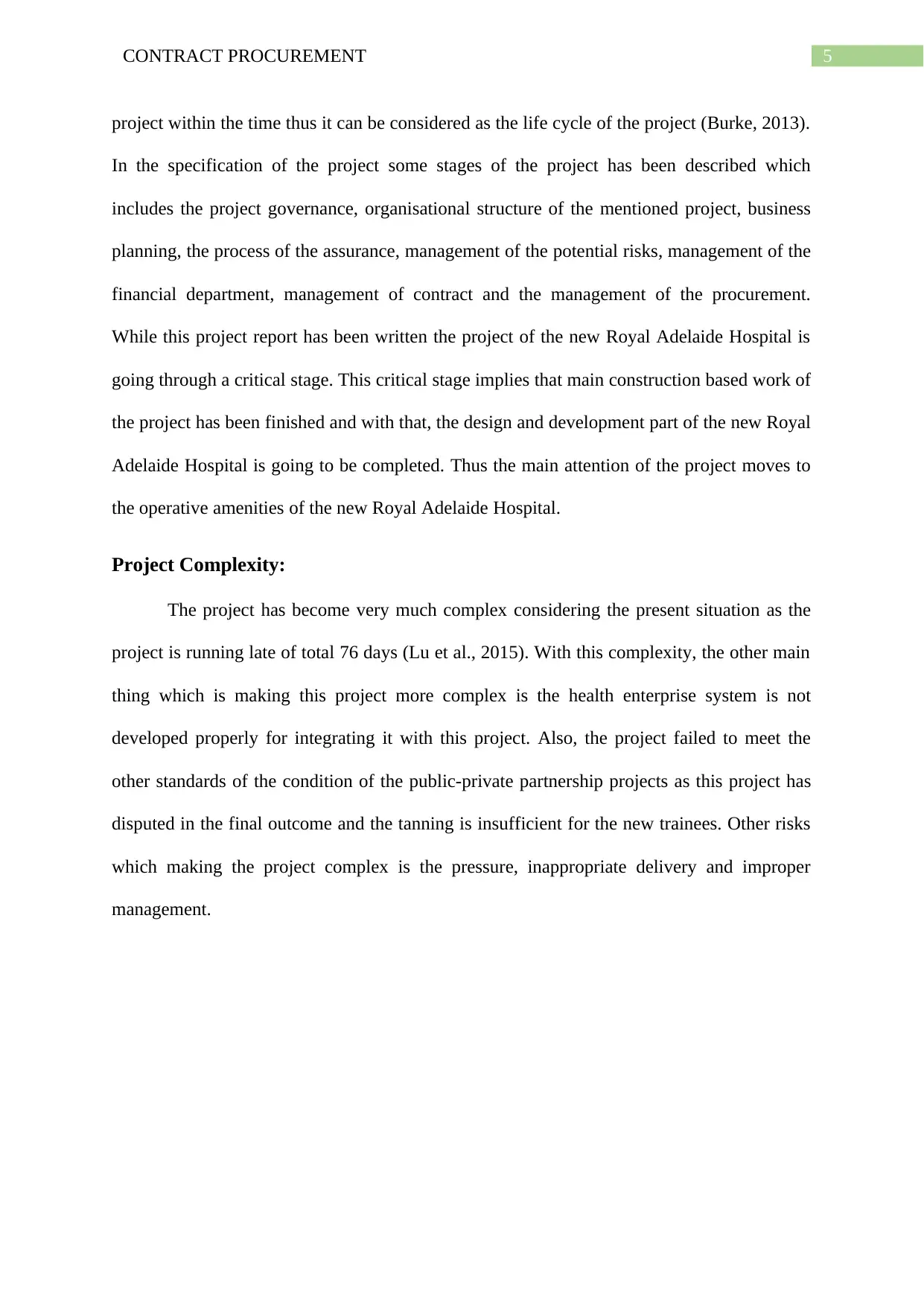
5CONTRACT PROCUREMENT
project within the time thus it can be considered as the life cycle of the project (Burke, 2013).
In the specification of the project some stages of the project has been described which
includes the project governance, organisational structure of the mentioned project, business
planning, the process of the assurance, management of the potential risks, management of the
financial department, management of contract and the management of the procurement.
While this project report has been written the project of the new Royal Adelaide Hospital is
going through a critical stage. This critical stage implies that main construction based work of
the project has been finished and with that, the design and development part of the new Royal
Adelaide Hospital is going to be completed. Thus the main attention of the project moves to
the operative amenities of the new Royal Adelaide Hospital.
Project Complexity:
The project has become very much complex considering the present situation as the
project is running late of total 76 days (Lu et al., 2015). With this complexity, the other main
thing which is making this project more complex is the health enterprise system is not
developed properly for integrating it with this project. Also, the project failed to meet the
other standards of the condition of the public-private partnership projects as this project has
disputed in the final outcome and the tanning is insufficient for the new trainees. Other risks
which making the project complex is the pressure, inappropriate delivery and improper
management.
project within the time thus it can be considered as the life cycle of the project (Burke, 2013).
In the specification of the project some stages of the project has been described which
includes the project governance, organisational structure of the mentioned project, business
planning, the process of the assurance, management of the potential risks, management of the
financial department, management of contract and the management of the procurement.
While this project report has been written the project of the new Royal Adelaide Hospital is
going through a critical stage. This critical stage implies that main construction based work of
the project has been finished and with that, the design and development part of the new Royal
Adelaide Hospital is going to be completed. Thus the main attention of the project moves to
the operative amenities of the new Royal Adelaide Hospital.
Project Complexity:
The project has become very much complex considering the present situation as the
project is running late of total 76 days (Lu et al., 2015). With this complexity, the other main
thing which is making this project more complex is the health enterprise system is not
developed properly for integrating it with this project. Also, the project failed to meet the
other standards of the condition of the public-private partnership projects as this project has
disputed in the final outcome and the tanning is insufficient for the new trainees. Other risks
which making the project complex is the pressure, inappropriate delivery and improper
management.
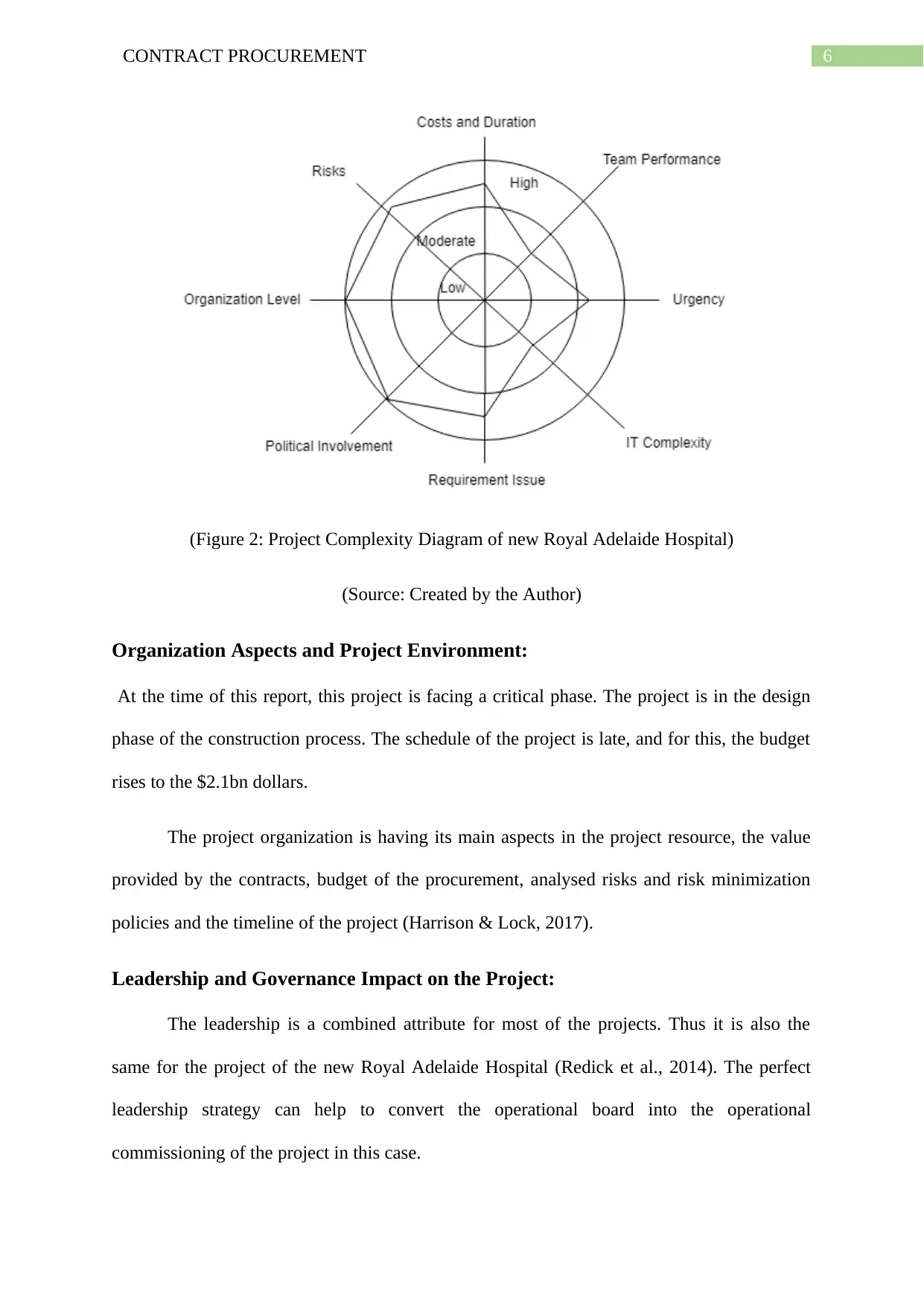
6CONTRACT PROCUREMENT
(Figure 2: Project Complexity Diagram of new Royal Adelaide Hospital)
(Source: Created by the Author)
Organization Aspects and Project Environment:
At the time of this report, this project is facing a critical phase. The project is in the design
phase of the construction process. The schedule of the project is late, and for this, the budget
rises to the $2.1bn dollars.
The project organization is having its main aspects in the project resource, the value
provided by the contracts, budget of the procurement, analysed risks and risk minimization
policies and the timeline of the project (Harrison & Lock, 2017).
Leadership and Governance Impact on the Project:
The leadership is a combined attribute for most of the projects. Thus it is also the
same for the project of the new Royal Adelaide Hospital (Redick et al., 2014). The perfect
leadership strategy can help to convert the operational board into the operational
commissioning of the project in this case.
(Figure 2: Project Complexity Diagram of new Royal Adelaide Hospital)
(Source: Created by the Author)
Organization Aspects and Project Environment:
At the time of this report, this project is facing a critical phase. The project is in the design
phase of the construction process. The schedule of the project is late, and for this, the budget
rises to the $2.1bn dollars.
The project organization is having its main aspects in the project resource, the value
provided by the contracts, budget of the procurement, analysed risks and risk minimization
policies and the timeline of the project (Harrison & Lock, 2017).
Leadership and Governance Impact on the Project:
The leadership is a combined attribute for most of the projects. Thus it is also the
same for the project of the new Royal Adelaide Hospital (Redick et al., 2014). The perfect
leadership strategy can help to convert the operational board into the operational
commissioning of the project in this case.
Paraphrase This Document
Need a fresh take? Get an instant paraphrase of this document with our AI Paraphraser
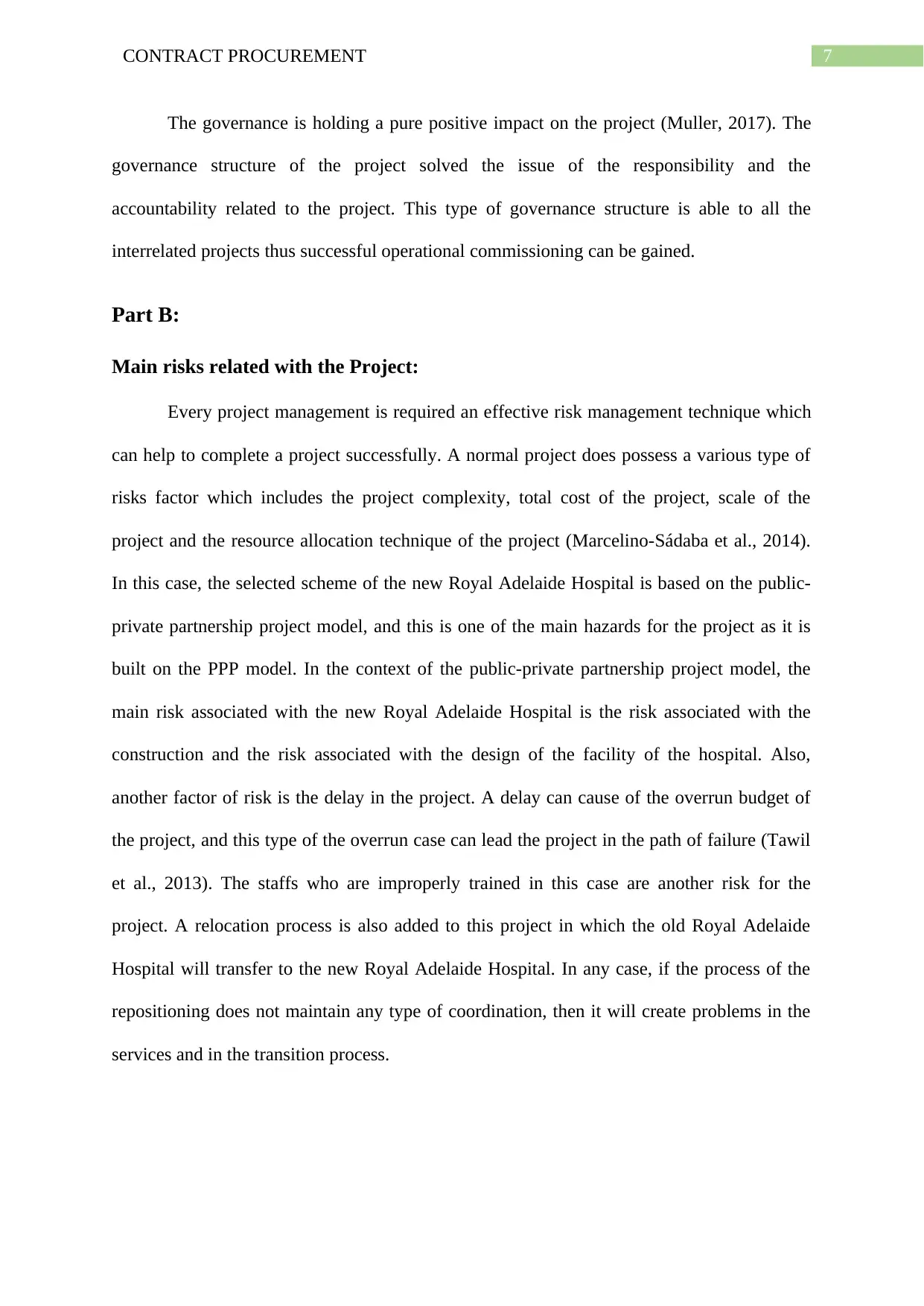
7CONTRACT PROCUREMENT
The governance is holding a pure positive impact on the project (Muller, 2017). The
governance structure of the project solved the issue of the responsibility and the
accountability related to the project. This type of governance structure is able to all the
interrelated projects thus successful operational commissioning can be gained.
Part B:
Main risks related with the Project:
Every project management is required an effective risk management technique which
can help to complete a project successfully. A normal project does possess a various type of
risks factor which includes the project complexity, total cost of the project, scale of the
project and the resource allocation technique of the project (Marcelino-Sádaba et al., 2014).
In this case, the selected scheme of the new Royal Adelaide Hospital is based on the public-
private partnership project model, and this is one of the main hazards for the project as it is
built on the PPP model. In the context of the public-private partnership project model, the
main risk associated with the new Royal Adelaide Hospital is the risk associated with the
construction and the risk associated with the design of the facility of the hospital. Also,
another factor of risk is the delay in the project. A delay can cause of the overrun budget of
the project, and this type of the overrun case can lead the project in the path of failure (Tawil
et al., 2013). The staffs who are improperly trained in this case are another risk for the
project. A relocation process is also added to this project in which the old Royal Adelaide
Hospital will transfer to the new Royal Adelaide Hospital. In any case, if the process of the
repositioning does not maintain any type of coordination, then it will create problems in the
services and in the transition process.
The governance is holding a pure positive impact on the project (Muller, 2017). The
governance structure of the project solved the issue of the responsibility and the
accountability related to the project. This type of governance structure is able to all the
interrelated projects thus successful operational commissioning can be gained.
Part B:
Main risks related with the Project:
Every project management is required an effective risk management technique which
can help to complete a project successfully. A normal project does possess a various type of
risks factor which includes the project complexity, total cost of the project, scale of the
project and the resource allocation technique of the project (Marcelino-Sádaba et al., 2014).
In this case, the selected scheme of the new Royal Adelaide Hospital is based on the public-
private partnership project model, and this is one of the main hazards for the project as it is
built on the PPP model. In the context of the public-private partnership project model, the
main risk associated with the new Royal Adelaide Hospital is the risk associated with the
construction and the risk associated with the design of the facility of the hospital. Also,
another factor of risk is the delay in the project. A delay can cause of the overrun budget of
the project, and this type of the overrun case can lead the project in the path of failure (Tawil
et al., 2013). The staffs who are improperly trained in this case are another risk for the
project. A relocation process is also added to this project in which the old Royal Adelaide
Hospital will transfer to the new Royal Adelaide Hospital. In any case, if the process of the
repositioning does not maintain any type of coordination, then it will create problems in the
services and in the transition process.
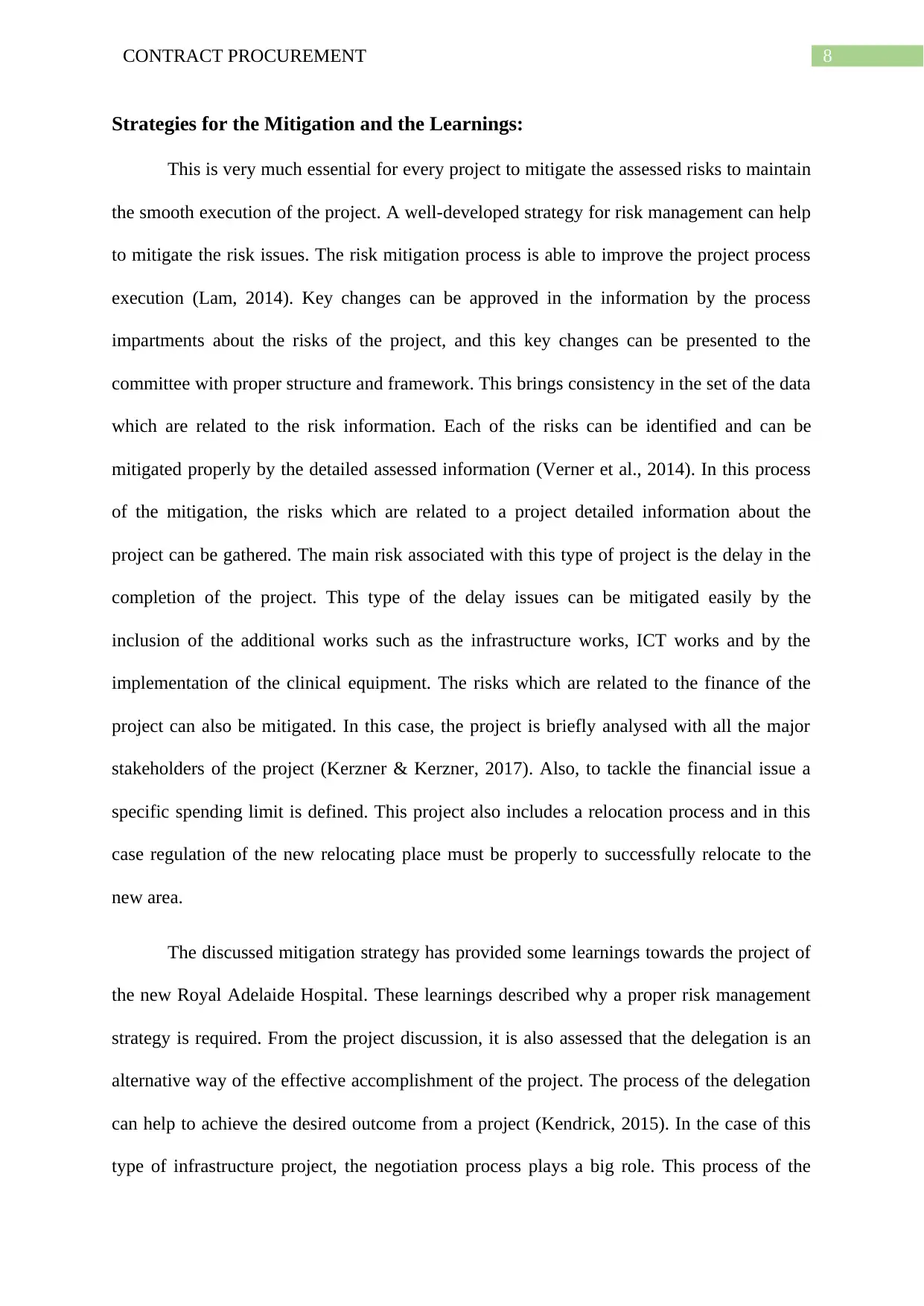
8CONTRACT PROCUREMENT
Strategies for the Mitigation and the Learnings:
This is very much essential for every project to mitigate the assessed risks to maintain
the smooth execution of the project. A well-developed strategy for risk management can help
to mitigate the risk issues. The risk mitigation process is able to improve the project process
execution (Lam, 2014). Key changes can be approved in the information by the process
impartments about the risks of the project, and this key changes can be presented to the
committee with proper structure and framework. This brings consistency in the set of the data
which are related to the risk information. Each of the risks can be identified and can be
mitigated properly by the detailed assessed information (Verner et al., 2014). In this process
of the mitigation, the risks which are related to a project detailed information about the
project can be gathered. The main risk associated with this type of project is the delay in the
completion of the project. This type of the delay issues can be mitigated easily by the
inclusion of the additional works such as the infrastructure works, ICT works and by the
implementation of the clinical equipment. The risks which are related to the finance of the
project can also be mitigated. In this case, the project is briefly analysed with all the major
stakeholders of the project (Kerzner & Kerzner, 2017). Also, to tackle the financial issue a
specific spending limit is defined. This project also includes a relocation process and in this
case regulation of the new relocating place must be properly to successfully relocate to the
new area.
The discussed mitigation strategy has provided some learnings towards the project of
the new Royal Adelaide Hospital. These learnings described why a proper risk management
strategy is required. From the project discussion, it is also assessed that the delegation is an
alternative way of the effective accomplishment of the project. The process of the delegation
can help to achieve the desired outcome from a project (Kendrick, 2015). In the case of this
type of infrastructure project, the negotiation process plays a big role. This process of the
Strategies for the Mitigation and the Learnings:
This is very much essential for every project to mitigate the assessed risks to maintain
the smooth execution of the project. A well-developed strategy for risk management can help
to mitigate the risk issues. The risk mitigation process is able to improve the project process
execution (Lam, 2014). Key changes can be approved in the information by the process
impartments about the risks of the project, and this key changes can be presented to the
committee with proper structure and framework. This brings consistency in the set of the data
which are related to the risk information. Each of the risks can be identified and can be
mitigated properly by the detailed assessed information (Verner et al., 2014). In this process
of the mitigation, the risks which are related to a project detailed information about the
project can be gathered. The main risk associated with this type of project is the delay in the
completion of the project. This type of the delay issues can be mitigated easily by the
inclusion of the additional works such as the infrastructure works, ICT works and by the
implementation of the clinical equipment. The risks which are related to the finance of the
project can also be mitigated. In this case, the project is briefly analysed with all the major
stakeholders of the project (Kerzner & Kerzner, 2017). Also, to tackle the financial issue a
specific spending limit is defined. This project also includes a relocation process and in this
case regulation of the new relocating place must be properly to successfully relocate to the
new area.
The discussed mitigation strategy has provided some learnings towards the project of
the new Royal Adelaide Hospital. These learnings described why a proper risk management
strategy is required. From the project discussion, it is also assessed that the delegation is an
alternative way of the effective accomplishment of the project. The process of the delegation
can help to achieve the desired outcome from a project (Kendrick, 2015). In the case of this
type of infrastructure project, the negotiation process plays a big role. This process of the
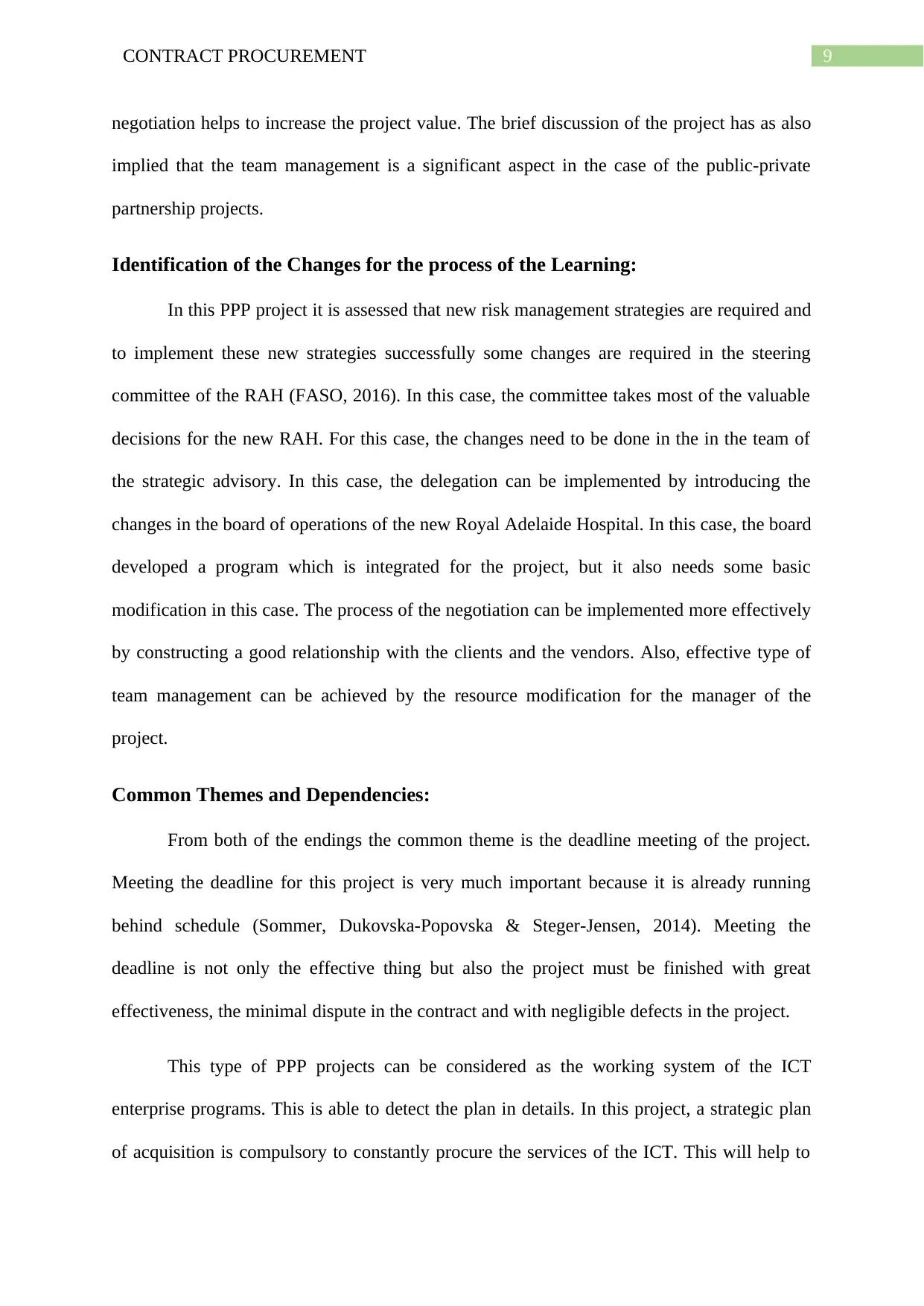
9CONTRACT PROCUREMENT
negotiation helps to increase the project value. The brief discussion of the project has as also
implied that the team management is a significant aspect in the case of the public-private
partnership projects.
Identification of the Changes for the process of the Learning:
In this PPP project it is assessed that new risk management strategies are required and
to implement these new strategies successfully some changes are required in the steering
committee of the RAH (FASO, 2016). In this case, the committee takes most of the valuable
decisions for the new RAH. For this case, the changes need to be done in the in the team of
the strategic advisory. In this case, the delegation can be implemented by introducing the
changes in the board of operations of the new Royal Adelaide Hospital. In this case, the board
developed a program which is integrated for the project, but it also needs some basic
modification in this case. The process of the negotiation can be implemented more effectively
by constructing a good relationship with the clients and the vendors. Also, effective type of
team management can be achieved by the resource modification for the manager of the
project.
Common Themes and Dependencies:
From both of the endings the common theme is the deadline meeting of the project.
Meeting the deadline for this project is very much important because it is already running
behind schedule (Sommer, Dukovska-Popovska & Steger-Jensen, 2014). Meeting the
deadline is not only the effective thing but also the project must be finished with great
effectiveness, the minimal dispute in the contract and with negligible defects in the project.
This type of PPP projects can be considered as the working system of the ICT
enterprise programs. This is able to detect the plan in details. In this project, a strategic plan
of acquisition is compulsory to constantly procure the services of the ICT. This will help to
negotiation helps to increase the project value. The brief discussion of the project has as also
implied that the team management is a significant aspect in the case of the public-private
partnership projects.
Identification of the Changes for the process of the Learning:
In this PPP project it is assessed that new risk management strategies are required and
to implement these new strategies successfully some changes are required in the steering
committee of the RAH (FASO, 2016). In this case, the committee takes most of the valuable
decisions for the new RAH. For this case, the changes need to be done in the in the team of
the strategic advisory. In this case, the delegation can be implemented by introducing the
changes in the board of operations of the new Royal Adelaide Hospital. In this case, the board
developed a program which is integrated for the project, but it also needs some basic
modification in this case. The process of the negotiation can be implemented more effectively
by constructing a good relationship with the clients and the vendors. Also, effective type of
team management can be achieved by the resource modification for the manager of the
project.
Common Themes and Dependencies:
From both of the endings the common theme is the deadline meeting of the project.
Meeting the deadline for this project is very much important because it is already running
behind schedule (Sommer, Dukovska-Popovska & Steger-Jensen, 2014). Meeting the
deadline is not only the effective thing but also the project must be finished with great
effectiveness, the minimal dispute in the contract and with negligible defects in the project.
This type of PPP projects can be considered as the working system of the ICT
enterprise programs. This is able to detect the plan in details. In this project, a strategic plan
of acquisition is compulsory to constantly procure the services of the ICT. This will help to
Secure Best Marks with AI Grader
Need help grading? Try our AI Grader for instant feedback on your assignments.
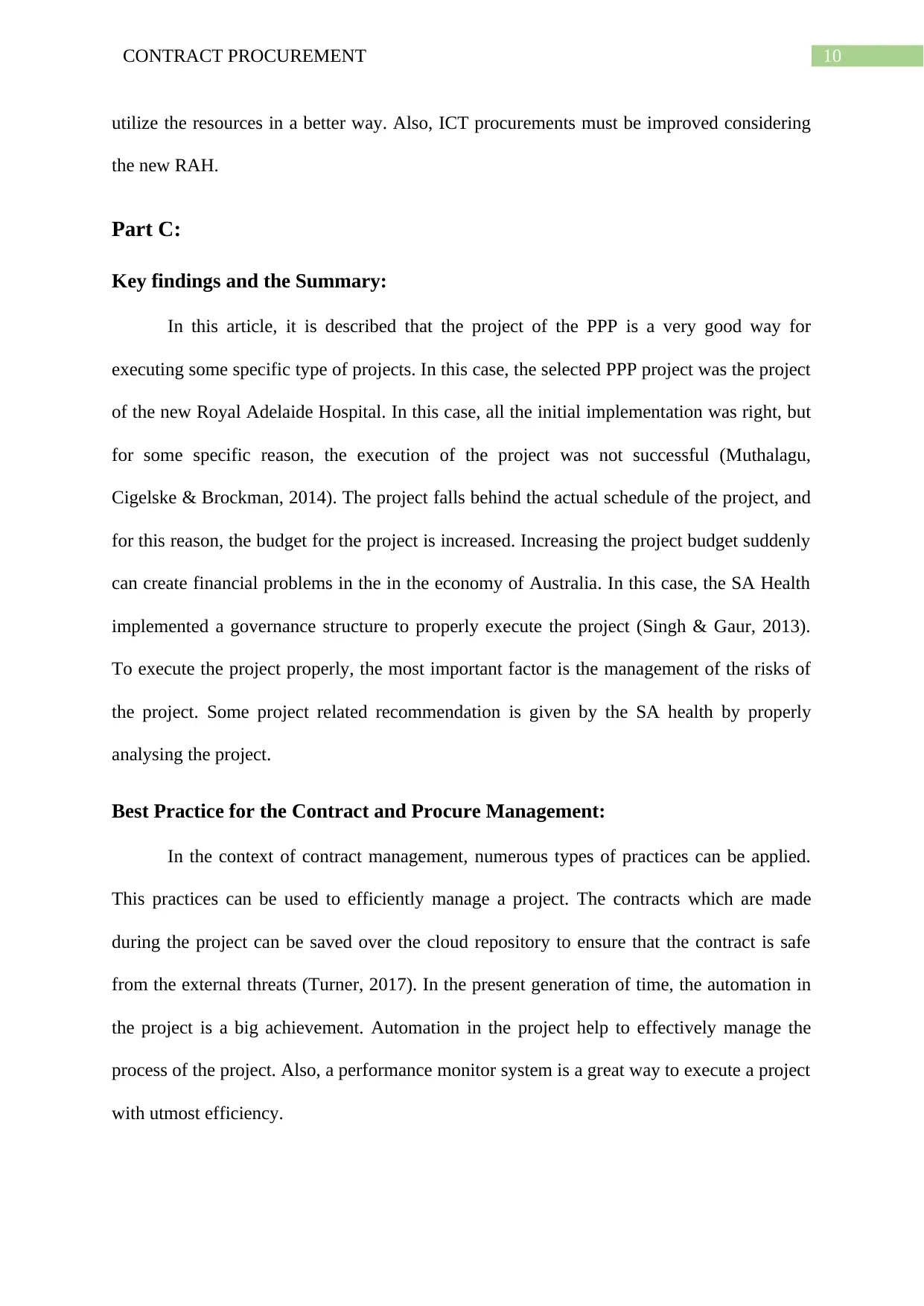
10CONTRACT PROCUREMENT
utilize the resources in a better way. Also, ICT procurements must be improved considering
the new RAH.
Part C:
Key findings and the Summary:
In this article, it is described that the project of the PPP is a very good way for
executing some specific type of projects. In this case, the selected PPP project was the project
of the new Royal Adelaide Hospital. In this case, all the initial implementation was right, but
for some specific reason, the execution of the project was not successful (Muthalagu,
Cigelske & Brockman, 2014). The project falls behind the actual schedule of the project, and
for this reason, the budget for the project is increased. Increasing the project budget suddenly
can create financial problems in the in the economy of Australia. In this case, the SA Health
implemented a governance structure to properly execute the project (Singh & Gaur, 2013).
To execute the project properly, the most important factor is the management of the risks of
the project. Some project related recommendation is given by the SA health by properly
analysing the project.
Best Practice for the Contract and Procure Management:
In the context of contract management, numerous types of practices can be applied.
This practices can be used to efficiently manage a project. The contracts which are made
during the project can be saved over the cloud repository to ensure that the contract is safe
from the external threats (Turner, 2017). In the present generation of time, the automation in
the project is a big achievement. Automation in the project help to effectively manage the
process of the project. Also, a performance monitor system is a great way to execute a project
with utmost efficiency.
utilize the resources in a better way. Also, ICT procurements must be improved considering
the new RAH.
Part C:
Key findings and the Summary:
In this article, it is described that the project of the PPP is a very good way for
executing some specific type of projects. In this case, the selected PPP project was the project
of the new Royal Adelaide Hospital. In this case, all the initial implementation was right, but
for some specific reason, the execution of the project was not successful (Muthalagu,
Cigelske & Brockman, 2014). The project falls behind the actual schedule of the project, and
for this reason, the budget for the project is increased. Increasing the project budget suddenly
can create financial problems in the in the economy of Australia. In this case, the SA Health
implemented a governance structure to properly execute the project (Singh & Gaur, 2013).
To execute the project properly, the most important factor is the management of the risks of
the project. Some project related recommendation is given by the SA health by properly
analysing the project.
Best Practice for the Contract and Procure Management:
In the context of contract management, numerous types of practices can be applied.
This practices can be used to efficiently manage a project. The contracts which are made
during the project can be saved over the cloud repository to ensure that the contract is safe
from the external threats (Turner, 2017). In the present generation of time, the automation in
the project is a big achievement. Automation in the project help to effectively manage the
process of the project. Also, a performance monitor system is a great way to execute a project
with utmost efficiency.
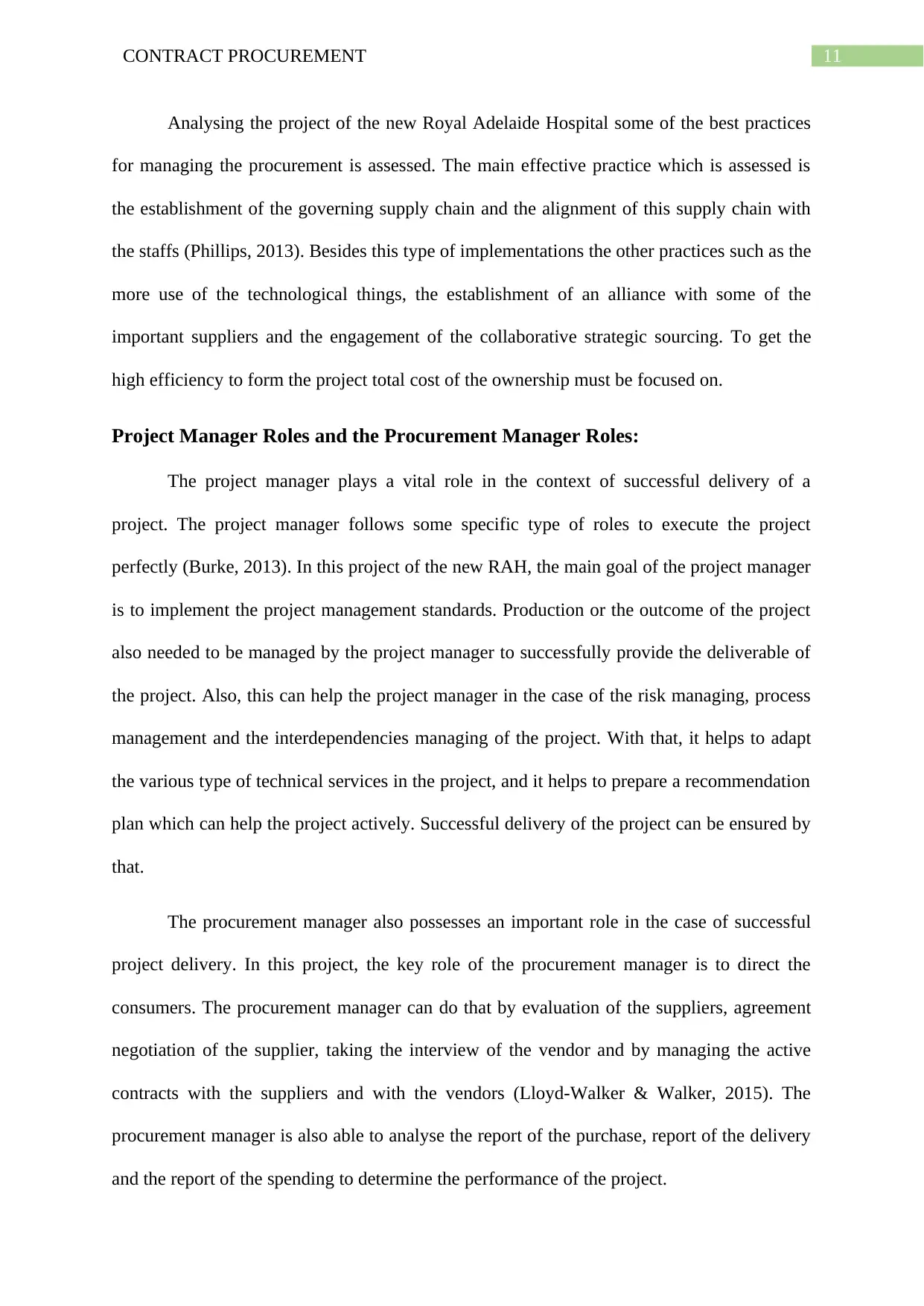
11CONTRACT PROCUREMENT
Analysing the project of the new Royal Adelaide Hospital some of the best practices
for managing the procurement is assessed. The main effective practice which is assessed is
the establishment of the governing supply chain and the alignment of this supply chain with
the staffs (Phillips, 2013). Besides this type of implementations the other practices such as the
more use of the technological things, the establishment of an alliance with some of the
important suppliers and the engagement of the collaborative strategic sourcing. To get the
high efficiency to form the project total cost of the ownership must be focused on.
Project Manager Roles and the Procurement Manager Roles:
The project manager plays a vital role in the context of successful delivery of a
project. The project manager follows some specific type of roles to execute the project
perfectly (Burke, 2013). In this project of the new RAH, the main goal of the project manager
is to implement the project management standards. Production or the outcome of the project
also needed to be managed by the project manager to successfully provide the deliverable of
the project. Also, this can help the project manager in the case of the risk managing, process
management and the interdependencies managing of the project. With that, it helps to adapt
the various type of technical services in the project, and it helps to prepare a recommendation
plan which can help the project actively. Successful delivery of the project can be ensured by
that.
The procurement manager also possesses an important role in the case of successful
project delivery. In this project, the key role of the procurement manager is to direct the
consumers. The procurement manager can do that by evaluation of the suppliers, agreement
negotiation of the supplier, taking the interview of the vendor and by managing the active
contracts with the suppliers and with the vendors (Lloyd-Walker & Walker, 2015). The
procurement manager is also able to analyse the report of the purchase, report of the delivery
and the report of the spending to determine the performance of the project.
Analysing the project of the new Royal Adelaide Hospital some of the best practices
for managing the procurement is assessed. The main effective practice which is assessed is
the establishment of the governing supply chain and the alignment of this supply chain with
the staffs (Phillips, 2013). Besides this type of implementations the other practices such as the
more use of the technological things, the establishment of an alliance with some of the
important suppliers and the engagement of the collaborative strategic sourcing. To get the
high efficiency to form the project total cost of the ownership must be focused on.
Project Manager Roles and the Procurement Manager Roles:
The project manager plays a vital role in the context of successful delivery of a
project. The project manager follows some specific type of roles to execute the project
perfectly (Burke, 2013). In this project of the new RAH, the main goal of the project manager
is to implement the project management standards. Production or the outcome of the project
also needed to be managed by the project manager to successfully provide the deliverable of
the project. Also, this can help the project manager in the case of the risk managing, process
management and the interdependencies managing of the project. With that, it helps to adapt
the various type of technical services in the project, and it helps to prepare a recommendation
plan which can help the project actively. Successful delivery of the project can be ensured by
that.
The procurement manager also possesses an important role in the case of successful
project delivery. In this project, the key role of the procurement manager is to direct the
consumers. The procurement manager can do that by evaluation of the suppliers, agreement
negotiation of the supplier, taking the interview of the vendor and by managing the active
contracts with the suppliers and with the vendors (Lloyd-Walker & Walker, 2015). The
procurement manager is also able to analyse the report of the purchase, report of the delivery
and the report of the spending to determine the performance of the project.
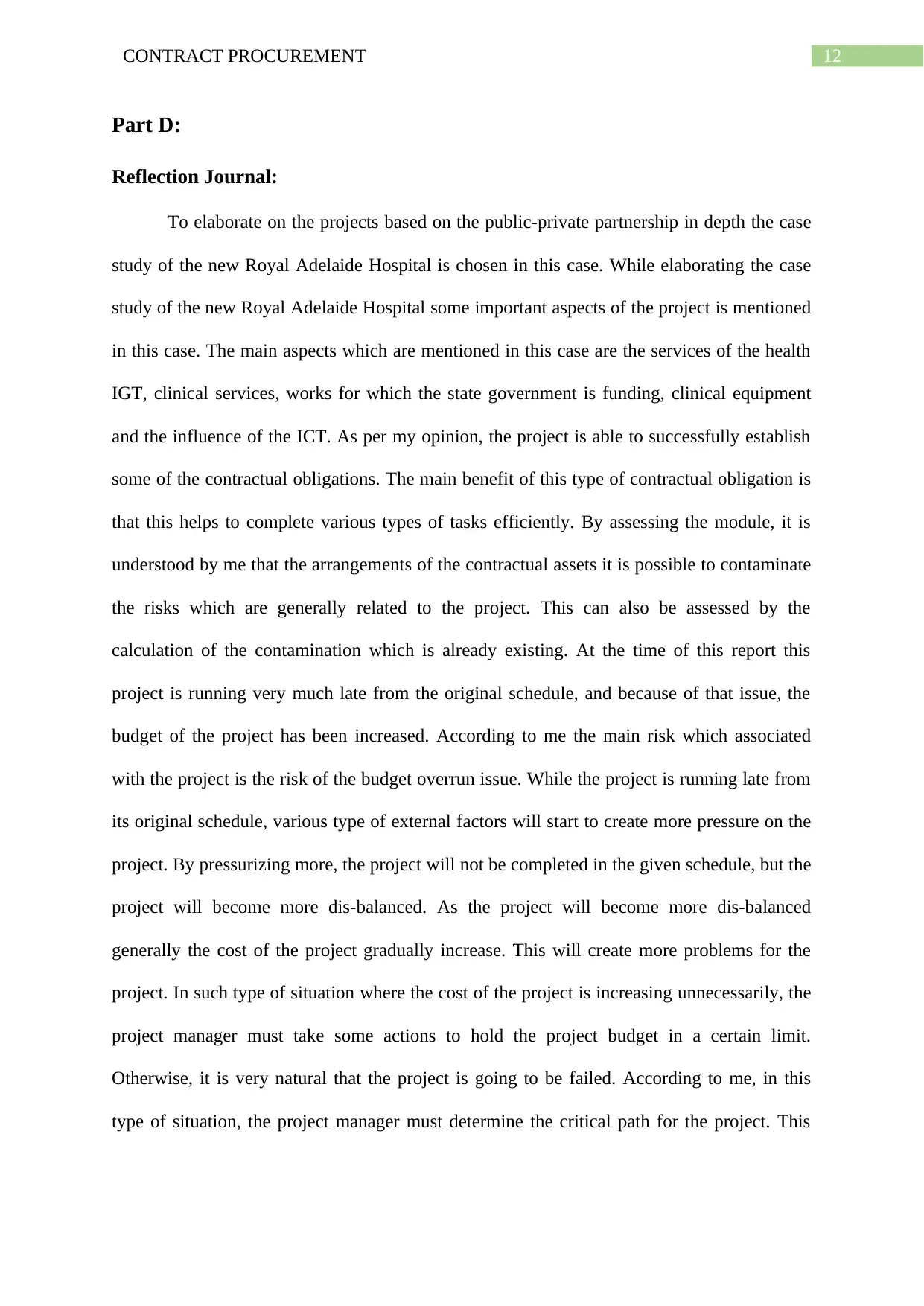
12CONTRACT PROCUREMENT
Part D:
Reflection Journal:
To elaborate on the projects based on the public-private partnership in depth the case
study of the new Royal Adelaide Hospital is chosen in this case. While elaborating the case
study of the new Royal Adelaide Hospital some important aspects of the project is mentioned
in this case. The main aspects which are mentioned in this case are the services of the health
IGT, clinical services, works for which the state government is funding, clinical equipment
and the influence of the ICT. As per my opinion, the project is able to successfully establish
some of the contractual obligations. The main benefit of this type of contractual obligation is
that this helps to complete various types of tasks efficiently. By assessing the module, it is
understood by me that the arrangements of the contractual assets it is possible to contaminate
the risks which are generally related to the project. This can also be assessed by the
calculation of the contamination which is already existing. At the time of this report this
project is running very much late from the original schedule, and because of that issue, the
budget of the project has been increased. According to me the main risk which associated
with the project is the risk of the budget overrun issue. While the project is running late from
its original schedule, various type of external factors will start to create more pressure on the
project. By pressurizing more, the project will not be completed in the given schedule, but the
project will become more dis-balanced. As the project will become more dis-balanced
generally the cost of the project gradually increase. This will create more problems for the
project. In such type of situation where the cost of the project is increasing unnecessarily, the
project manager must take some actions to hold the project budget in a certain limit.
Otherwise, it is very natural that the project is going to be failed. According to me, in this
type of situation, the project manager must determine the critical path for the project. This
Part D:
Reflection Journal:
To elaborate on the projects based on the public-private partnership in depth the case
study of the new Royal Adelaide Hospital is chosen in this case. While elaborating the case
study of the new Royal Adelaide Hospital some important aspects of the project is mentioned
in this case. The main aspects which are mentioned in this case are the services of the health
IGT, clinical services, works for which the state government is funding, clinical equipment
and the influence of the ICT. As per my opinion, the project is able to successfully establish
some of the contractual obligations. The main benefit of this type of contractual obligation is
that this helps to complete various types of tasks efficiently. By assessing the module, it is
understood by me that the arrangements of the contractual assets it is possible to contaminate
the risks which are generally related to the project. This can also be assessed by the
calculation of the contamination which is already existing. At the time of this report this
project is running very much late from the original schedule, and because of that issue, the
budget of the project has been increased. According to me the main risk which associated
with the project is the risk of the budget overrun issue. While the project is running late from
its original schedule, various type of external factors will start to create more pressure on the
project. By pressurizing more, the project will not be completed in the given schedule, but the
project will become more dis-balanced. As the project will become more dis-balanced
generally the cost of the project gradually increase. This will create more problems for the
project. In such type of situation where the cost of the project is increasing unnecessarily, the
project manager must take some actions to hold the project budget in a certain limit.
Otherwise, it is very natural that the project is going to be failed. According to me, in this
type of situation, the project manager must determine the critical path for the project. This
Paraphrase This Document
Need a fresh take? Get an instant paraphrase of this document with our AI Paraphraser
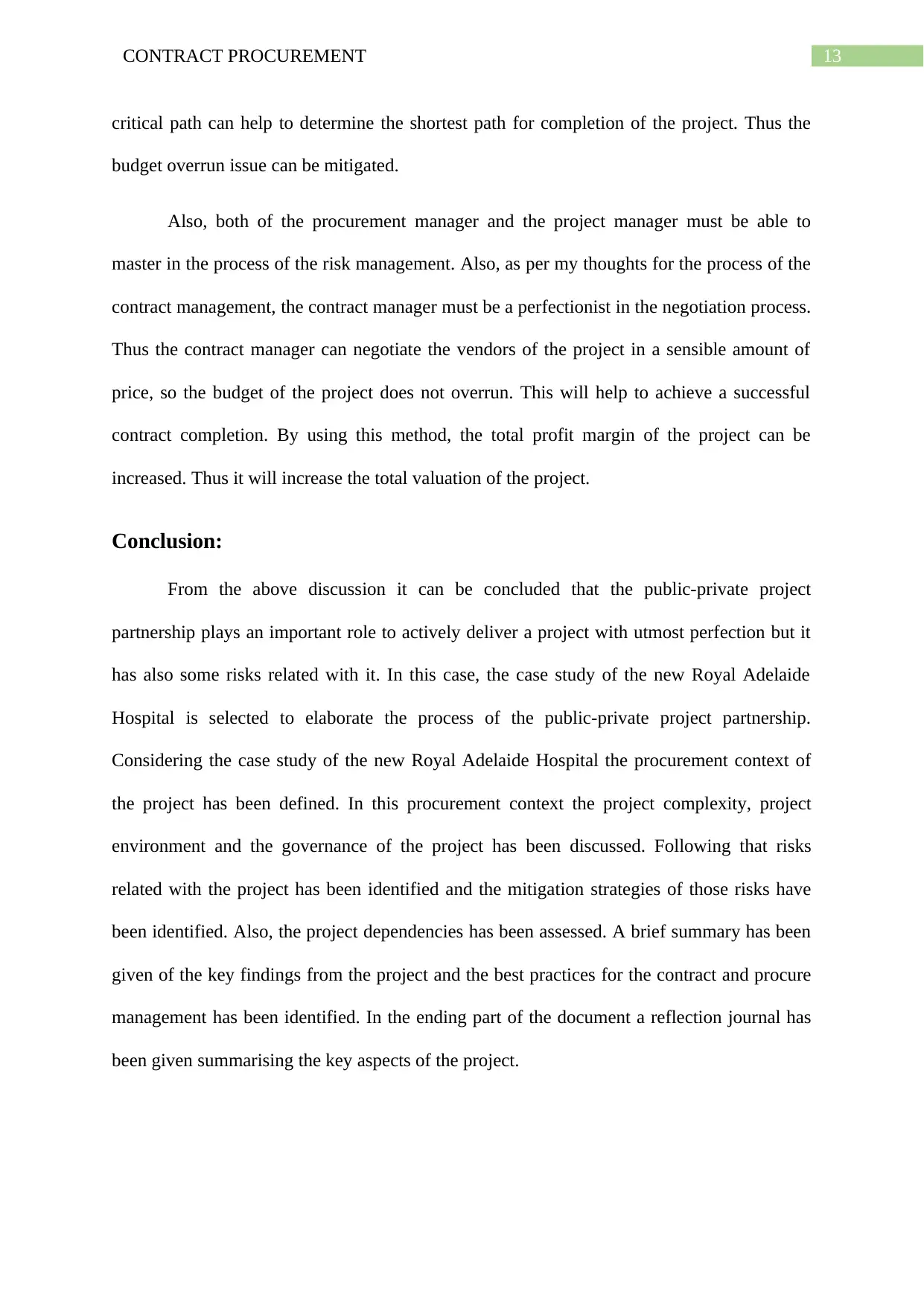
13CONTRACT PROCUREMENT
critical path can help to determine the shortest path for completion of the project. Thus the
budget overrun issue can be mitigated.
Also, both of the procurement manager and the project manager must be able to
master in the process of the risk management. Also, as per my thoughts for the process of the
contract management, the contract manager must be a perfectionist in the negotiation process.
Thus the contract manager can negotiate the vendors of the project in a sensible amount of
price, so the budget of the project does not overrun. This will help to achieve a successful
contract completion. By using this method, the total profit margin of the project can be
increased. Thus it will increase the total valuation of the project.
Conclusion:
From the above discussion it can be concluded that the public-private project
partnership plays an important role to actively deliver a project with utmost perfection but it
has also some risks related with it. In this case, the case study of the new Royal Adelaide
Hospital is selected to elaborate the process of the public-private project partnership.
Considering the case study of the new Royal Adelaide Hospital the procurement context of
the project has been defined. In this procurement context the project complexity, project
environment and the governance of the project has been discussed. Following that risks
related with the project has been identified and the mitigation strategies of those risks have
been identified. Also, the project dependencies has been assessed. A brief summary has been
given of the key findings from the project and the best practices for the contract and procure
management has been identified. In the ending part of the document a reflection journal has
been given summarising the key aspects of the project.
critical path can help to determine the shortest path for completion of the project. Thus the
budget overrun issue can be mitigated.
Also, both of the procurement manager and the project manager must be able to
master in the process of the risk management. Also, as per my thoughts for the process of the
contract management, the contract manager must be a perfectionist in the negotiation process.
Thus the contract manager can negotiate the vendors of the project in a sensible amount of
price, so the budget of the project does not overrun. This will help to achieve a successful
contract completion. By using this method, the total profit margin of the project can be
increased. Thus it will increase the total valuation of the project.
Conclusion:
From the above discussion it can be concluded that the public-private project
partnership plays an important role to actively deliver a project with utmost perfection but it
has also some risks related with it. In this case, the case study of the new Royal Adelaide
Hospital is selected to elaborate the process of the public-private project partnership.
Considering the case study of the new Royal Adelaide Hospital the procurement context of
the project has been defined. In this procurement context the project complexity, project
environment and the governance of the project has been discussed. Following that risks
related with the project has been identified and the mitigation strategies of those risks have
been identified. Also, the project dependencies has been assessed. A brief summary has been
given of the key findings from the project and the best practices for the contract and procure
management has been identified. In the ending part of the document a reflection journal has
been given summarising the key aspects of the project.
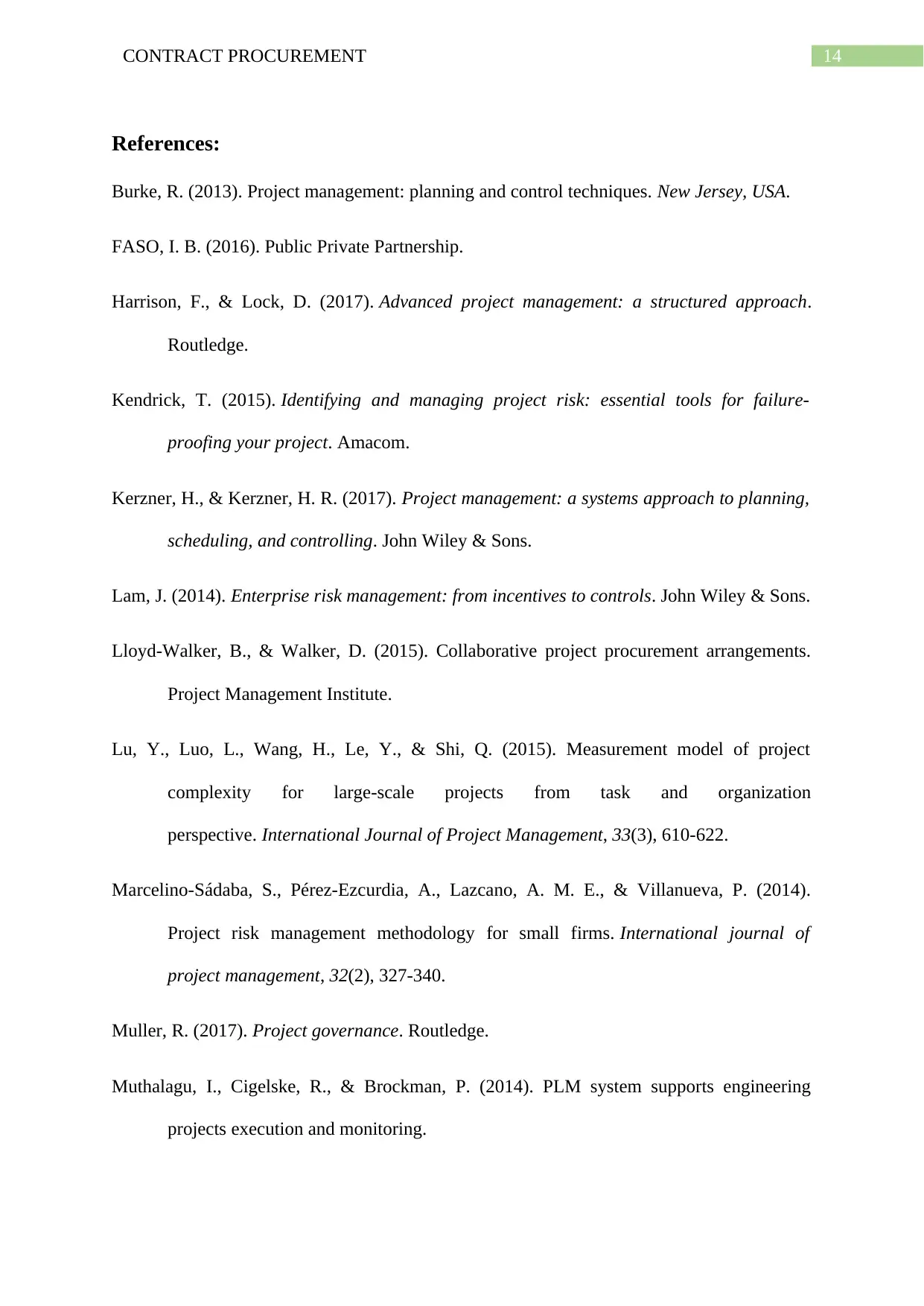
14CONTRACT PROCUREMENT
References:
Burke, R. (2013). Project management: planning and control techniques. New Jersey, USA.
FASO, I. B. (2016). Public Private Partnership.
Harrison, F., & Lock, D. (2017). Advanced project management: a structured approach.
Routledge.
Kendrick, T. (2015). Identifying and managing project risk: essential tools for failure-
proofing your project. Amacom.
Kerzner, H., & Kerzner, H. R. (2017). Project management: a systems approach to planning,
scheduling, and controlling. John Wiley & Sons.
Lam, J. (2014). Enterprise risk management: from incentives to controls. John Wiley & Sons.
Lloyd-Walker, B., & Walker, D. (2015). Collaborative project procurement arrangements.
Project Management Institute.
Lu, Y., Luo, L., Wang, H., Le, Y., & Shi, Q. (2015). Measurement model of project
complexity for large-scale projects from task and organization
perspective. International Journal of Project Management, 33(3), 610-622.
Marcelino-Sádaba, S., Pérez-Ezcurdia, A., Lazcano, A. M. E., & Villanueva, P. (2014).
Project risk management methodology for small firms. International journal of
project management, 32(2), 327-340.
Muller, R. (2017). Project governance. Routledge.
Muthalagu, I., Cigelske, R., & Brockman, P. (2014). PLM system supports engineering
projects execution and monitoring.
References:
Burke, R. (2013). Project management: planning and control techniques. New Jersey, USA.
FASO, I. B. (2016). Public Private Partnership.
Harrison, F., & Lock, D. (2017). Advanced project management: a structured approach.
Routledge.
Kendrick, T. (2015). Identifying and managing project risk: essential tools for failure-
proofing your project. Amacom.
Kerzner, H., & Kerzner, H. R. (2017). Project management: a systems approach to planning,
scheduling, and controlling. John Wiley & Sons.
Lam, J. (2014). Enterprise risk management: from incentives to controls. John Wiley & Sons.
Lloyd-Walker, B., & Walker, D. (2015). Collaborative project procurement arrangements.
Project Management Institute.
Lu, Y., Luo, L., Wang, H., Le, Y., & Shi, Q. (2015). Measurement model of project
complexity for large-scale projects from task and organization
perspective. International Journal of Project Management, 33(3), 610-622.
Marcelino-Sádaba, S., Pérez-Ezcurdia, A., Lazcano, A. M. E., & Villanueva, P. (2014).
Project risk management methodology for small firms. International journal of
project management, 32(2), 327-340.
Muller, R. (2017). Project governance. Routledge.
Muthalagu, I., Cigelske, R., & Brockman, P. (2014). PLM system supports engineering
projects execution and monitoring.
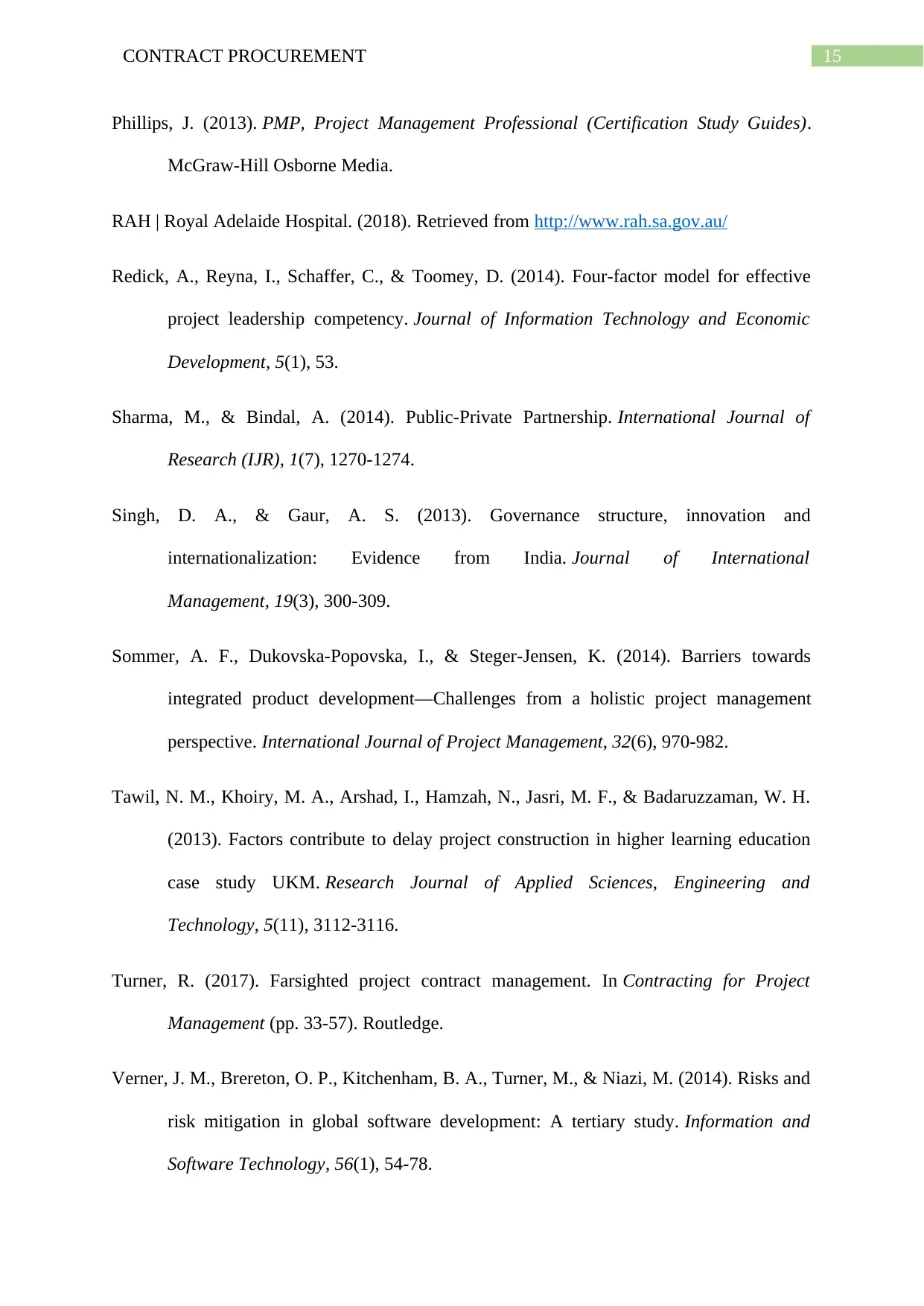
15CONTRACT PROCUREMENT
Phillips, J. (2013). PMP, Project Management Professional (Certification Study Guides).
McGraw-Hill Osborne Media.
RAH | Royal Adelaide Hospital. (2018). Retrieved from http://www.rah.sa.gov.au/
Redick, A., Reyna, I., Schaffer, C., & Toomey, D. (2014). Four-factor model for effective
project leadership competency. Journal of Information Technology and Economic
Development, 5(1), 53.
Sharma, M., & Bindal, A. (2014). Public-Private Partnership. International Journal of
Research (IJR), 1(7), 1270-1274.
Singh, D. A., & Gaur, A. S. (2013). Governance structure, innovation and
internationalization: Evidence from India. Journal of International
Management, 19(3), 300-309.
Sommer, A. F., Dukovska-Popovska, I., & Steger-Jensen, K. (2014). Barriers towards
integrated product development—Challenges from a holistic project management
perspective. International Journal of Project Management, 32(6), 970-982.
Tawil, N. M., Khoiry, M. A., Arshad, I., Hamzah, N., Jasri, M. F., & Badaruzzaman, W. H.
(2013). Factors contribute to delay project construction in higher learning education
case study UKM. Research Journal of Applied Sciences, Engineering and
Technology, 5(11), 3112-3116.
Turner, R. (2017). Farsighted project contract management. In Contracting for Project
Management (pp. 33-57). Routledge.
Verner, J. M., Brereton, O. P., Kitchenham, B. A., Turner, M., & Niazi, M. (2014). Risks and
risk mitigation in global software development: A tertiary study. Information and
Software Technology, 56(1), 54-78.
Phillips, J. (2013). PMP, Project Management Professional (Certification Study Guides).
McGraw-Hill Osborne Media.
RAH | Royal Adelaide Hospital. (2018). Retrieved from http://www.rah.sa.gov.au/
Redick, A., Reyna, I., Schaffer, C., & Toomey, D. (2014). Four-factor model for effective
project leadership competency. Journal of Information Technology and Economic
Development, 5(1), 53.
Sharma, M., & Bindal, A. (2014). Public-Private Partnership. International Journal of
Research (IJR), 1(7), 1270-1274.
Singh, D. A., & Gaur, A. S. (2013). Governance structure, innovation and
internationalization: Evidence from India. Journal of International
Management, 19(3), 300-309.
Sommer, A. F., Dukovska-Popovska, I., & Steger-Jensen, K. (2014). Barriers towards
integrated product development—Challenges from a holistic project management
perspective. International Journal of Project Management, 32(6), 970-982.
Tawil, N. M., Khoiry, M. A., Arshad, I., Hamzah, N., Jasri, M. F., & Badaruzzaman, W. H.
(2013). Factors contribute to delay project construction in higher learning education
case study UKM. Research Journal of Applied Sciences, Engineering and
Technology, 5(11), 3112-3116.
Turner, R. (2017). Farsighted project contract management. In Contracting for Project
Management (pp. 33-57). Routledge.
Verner, J. M., Brereton, O. P., Kitchenham, B. A., Turner, M., & Niazi, M. (2014). Risks and
risk mitigation in global software development: A tertiary study. Information and
Software Technology, 56(1), 54-78.
1 out of 16
Related Documents
Your All-in-One AI-Powered Toolkit for Academic Success.
+13062052269
info@desklib.com
Available 24*7 on WhatsApp / Email
![[object Object]](/_next/static/media/star-bottom.7253800d.svg)
Unlock your academic potential
© 2024 | Zucol Services PVT LTD | All rights reserved.




